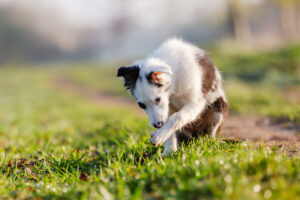Training is more than just teaching commands; it’s about harnessing the unique potential of your furry best friend. In this guide, we’ll give you some dog training tips for your canine companion, from pup to adult.
Whether you’ve just brought home a tiny fluffball or are navigating the uncharted waters of adopting an older rescue, these training tips will become your trusted companions on this exciting canine adventure.
Level 1: Puppyhood – The Foundational Years
Puppyhood is the golden age of learning for canines. From eight weeks to around six months, your pup is akin to a sponge, soaking in experiences and forming behaviors that will last a lifetime. Here’s how to set a tail-wagging good foundation for training:
Early Socialization is Key
Introduce your puppy to various environments, people, and animals. This early exposure reduces the risk of developing phobias and aggression. Controlled experiences at dog parks or puppy socialization classes can shape their future interactions positively.
Basic Commands to Start With
Begin with foundational commands like ‘sit,’ ‘stay,’ and ‘come.’ Keep sessions short but frequent, using plenty of positive reinforcement – treats, toys, and verbal praise. Remember to always associate the command with the action and reward compliance.
Crate Training for a Comfy Den
A properly introduced crate can be your pup’s haven. Use it for short periods, gradually building up so they associate it with safety and quiet time. Never use the crate as punishment, and ensure it’s a pleasant space equipped with bedding and toys.
Level 2: Adulthood – Refinement and Fine-Tuning
As your puppy grows, the training emphasis shifts from fundamental to fine-tuning. From six months to two years, adulthood brings the challenges of distraction and independence. These strategies will help reinforce good behavior and maintain your dog’s mental acuity:
Advanced Obedience for Enhanced Control
Transition to more complex skills like ‘heel,’ ‘leave it,’ and ‘down.’ Leash walking is particularly crucial; walk on a loose leash and teach your dog to sit when you stop. These commands will come in handy, especially during outdoor activities and when guests arrive.
Distraction Training for the Real World
Take your dog’s training to parks, cafes, and other public places to work on obedience with increasing distractions. Use high-value treats to keep their focus, gradually reducing the need for rewards as they improve.
Mental Stimulation to Satisfy Curiosity
Engage your adult dog in brain games and puzzles to combat any tendency for boredom, which can lead to destructive behaviors. Conceal treats in your home for them to find, or invest in toys that require manipulation to access a snack.
Handling the Transition from Puppy to Adult Dog
The end of the puppy phase is bittersweet. By one year or when your vet considers them fully grown, they enter adolescence, a period marked by a testing of limits. Maintain consistency and patience, doubling down on positive reinforcement. Dogs thrive on routine, and this is a time to hold steady.
Level 3: Mature Years – Reinforcing the Bonds
Mature dogs are like seasoned professionals. They know the rules, but they’ll appreciate continued training that aligns with their aging bodies and minds. Consider these strategies for the mature dog phase:
Age-Appropriate Activities
Adjust the intensity and type of physical activity based on their age and energy levels. Long walks and light jogs are perfect, and for more sedate dogs, regular but gentle exercise keeps them in great shape.
Brushing Up on the Basics
Don’t assume that your older dog’s training is set in stone. Regular reinforcement and the occasional refresher on commands can be a rewarding bonding experience, reminding them that learning is lifelong.
Addressing Behavioral Changes
Stay alert to any shifts in behavior that could indicate health issues or discomfort. Consult with your vet if your dog suddenly seems reluctant to obey or engage in usual activities, as this could signal a need for medical attention.
Training Multiple Dogs
Introducing a new puppy to your adult dog can be a walk on a tightrope. Alternate between group and individual sessions, rewarding each for their individual achievements. Over time, they’ll learn from each other, and you’ll witness a beautifully harmonious relationship.
Wrapping Up
Dog training is a labor of love that requires dedication, a good understanding of your dog’s breed traits, and plenty of patience. The goal is not just a well-trained dog, but a strong, loving relationship built on communication and trust. Reflect on the unique personality of your furry friend as you tailor your training approach, and don’t forget to enjoy the process – playful moments are just as important as practice.
In conclusion, the hardest age to train a dog is not determined by a number, but by the owner’s dedication and the dog’s individual characteristics. By applying these strategies consistently throughout your dog’s life, you’ll instill manners, reinforce good behavior, and create an unbreakable bond. Remember, it’s a marathon, not a sprint, and the rewards of a companion that can gracefully maneuver through life’s adventures are immeasurable. Start today, adapt as needed, and watch your four-legged family member flourish.
Get started today by joining the Truffle Paws family and embrace a worry-free pet parenthood journey.







